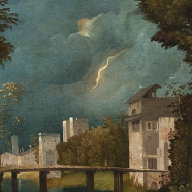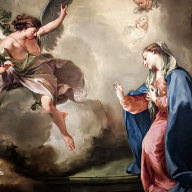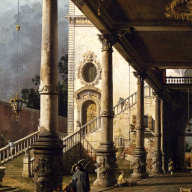A wall surface, that is part of a historic building, always contains a great deal of data that can be useful in different, although interconnected, fields of knowledge. Among the many, we will limit to mentioning those related to the history of the building, the construction techniques of the masonry structures and their finishes — including decorative finishes — as well as those that make the compositional and microstructural framework. Reading this set of data is always necessary, especially when approaching a knowledge process aimed at a conservation work.
Decorative finishes that may be present on a wall surface were mentioned above; these can include mural paintings and cycles of stuccoworks decorations. In this regard, there are many buildings and their interior spaces that can serve as useful examples when approaching a tangible heritage, with the aim of modeling the knowledge domain to which it belongs.
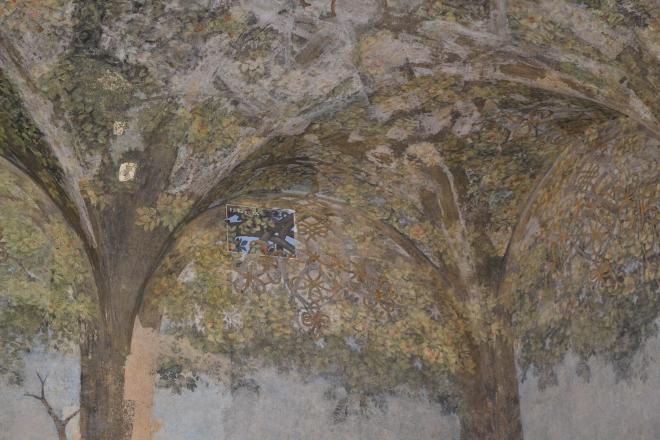
In recent years, the Sala delle Asse, located on the ground floor of the Torre della Falconiera in the Sforza Castle in Milan, has been the subject of extensive and in-depth investigative studies, aimed at designing and carrying out pilot conservation works. These were intended to present the preliminary results of the conservation efforts to the public, and subsequently to extend the cleaning, consolidation, and pictorial integration to the entire surface. The Sala presents a palimpsest of different paintings executed according to a complex stratigraphic sequence and is therefore a source of numerous interwoven elements of information.
The murals and wall drawings in the Sala depict a pergola made up of mulberry trees; the tree trunks are distributed along the walls, and the branches intertwine across the vault. Accompanying them are golden ropes forming a pattern of interweaving and shields bearing heraldic mottos.
In the corner opposite the current entrance — which includes the Sala in the exhibition route of Milan’s civic museums — lies the so-called Leonardo Monochrome, universally attributed by scholars to the hand of Leonardo da Vinci himself. The term “monochrome” refers to the overall tones of the composition, which depicts a section of landscape with rocks, roots, and other vegetal elements, rendered in shades ranging from brown to sepia.
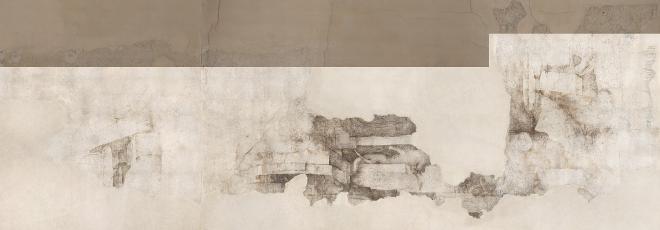
A close-up view reveals two distinct types of strokes. The first is applied with a brush, featuring soft and broad lines in sepia tones. The second is darker — almost black — with a rough and dry quality and was likely applied with a pointed instrument such as charcoal stick.
This composition rests on a dove-grey plaster that is not particularly refined in terms of grain size. Occasionally, plant fibers emerge from the surface — these were used in the mix to give the plaster greater tensile strength and to limit cracking during shrinkage.
Much has been written about the inventive idea that led Leonardo to compose this monochrome: is it a preparatory drawing or a conceptual project not yet fully defined? Was it meant to be covered with polychrome painting layers as part of a broader compositional plan, one that — incorporating the rest of the painted decoration — would invite visitors into a loggia? Did the illusionistic effect lead the viewer’s gaze beyond the physical walls of the tower and into the forest behind the Castle, once used by the Sforza family for hunting?
The removal of whitewash carried out in recent years revealed several additional small details painted in monochrome on the plaster. These very specific findings have sparked debate about the intention behind Leonardo’s execution of the monochrome: was it a detailed preparatory drawing meant to be completed with polychrome painting, or rather a drawing exercise focused on a detail that Leonardo considered important, due to its position on the wall or its compositional significance? In other words, did Leonardo see that point of the composition as especially significant and therefore wanted to design it with particular care, or was he simply experimenting — using the wall of the Sala as if it were one of his sketch sheets?
It will not be easy to answer these questions, but the data gathered during the intense work in the Sala over recent years offers many points for reflection.
Today, the vault and the intertwining branches appear in polychrome, the result of a long and complex conservation history. By the end of the 19th century, the painting had been hidden beneath several layers of lime whitewash. The first removal of these whitewashes was carried out using mechanical methods during the restoration project led by Luca Beltrami, aimed at converting the Castle’s rooms into a museum space — this, after a long period of neglect that had almost led to the building’s demolition. It is difficult to say how much of Leonardo’s original paint layer remained at that point, but probably very little. So much so that the restorer/decorator Rusca, in charge of the work, almost entirely repainted the phytomorphic subjects, recreating a decorative scheme vaguely in the Beaux-Arts style. Some fragments of these repainted sections, a few dozen centimetres in size, are still visible today as historical evidence. Later, Ottemi della Rotta — a prominent restorer in post-war Milan — worked on the tormented painted surfaces but did not remove Rusca’s repainting. To mask the glaring gaps, Ottemi della Rotta applied a brownish material using a sponge technique.
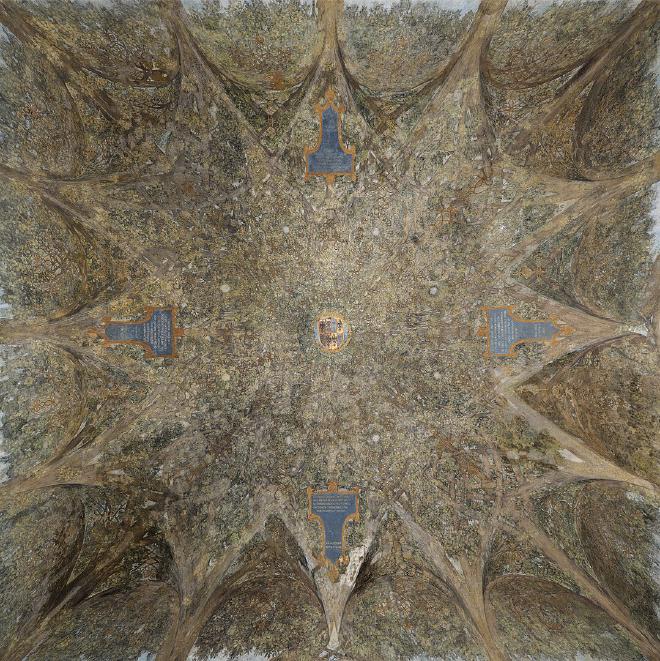
The knowledge acquired regarding the layers of painting and drawing in the Sala delle Asse now provides a valuable comparative tool for modelling other similar case studies. The Sala delle Asse and its surfaces represent a broad case history of what can be found on a painted plaster surface: monochrome, polychrome, preparatory drawing, whitewash, lacuna, repainting. All these categories find in this space a paradigmatic example.
Bibliography#
Michela Palazzo and Francesca Tasso (eds.), “Leonardo da Vinci. The Sala delle Asse of the Sforza Castle”. Silvana Publisher. 2017
Cite as:
Scarpa, E., & Valente, R. (2025). Case Study #2: What is an Epigraph?. Zenodo. https://doi.org/10.5281/zenodo.15167879
